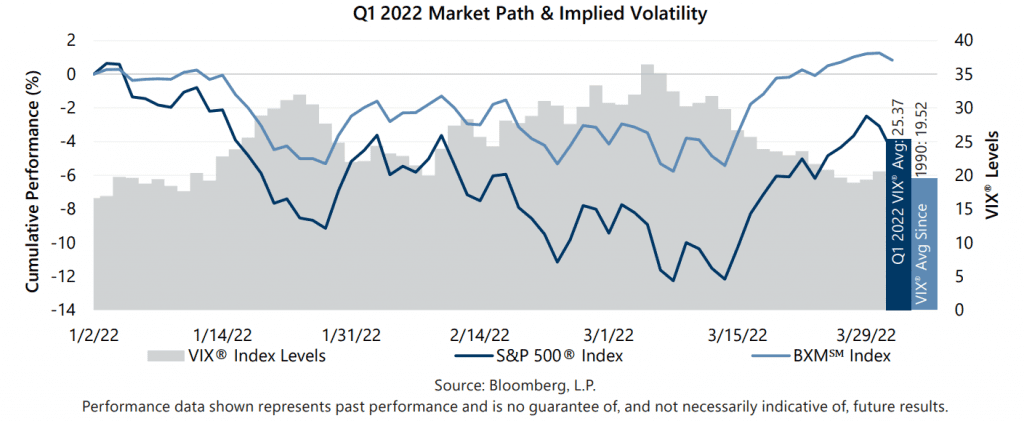The S&P 500® Index returned -4.60% in the first quarter of 2022 with monthly returns of -5.17%, -2.99% and 3.71% for January, February and March, respectively. War in Ukraine paired with rising interest rates, record inflation and strict sanctions on Russia that helped drive oil above $100 per barrel drove the market to a 12.82% loss from its year-to-date peak on January 3 through March 8. As investors digested their growing list of concerns, the market staged a late-quarter rally and partial recovery, climbing 8.73% from March 8 through quarter-end.
U.S. macroeconomic data released in March revealed a stable macroeconomic environment and strong corporate earnings despite global turmoil. The third estimate of Gross Domestic Product for the fourth quarter of 2021 showed that the U.S. economy grew at an annualized rate of 6.9%, below the consensus expectation. The unemployment rate was slightly better than the consensus estimate, declining from 4.0% in January to 3.8% in February while the participation rate ticked up to 62.3%. The February Consumer Price Index, released March 10, showed no signs of slowing down with a year-over-year increase of 7.9% which matched the consensus expectation. Fourth quarter aggregate operating earnings were on track to climb over 9% quarter-over-quarter while increasing more than 70% year-over-year. With over 99% of companies reporting, more than 79% met or exceeded analyst estimates.
Implied volatility, as measured by the Cboe® Volatility Index (the VIX®) averaged 25.37 in the first quarter of 2022. Consistent with its typical relationship, average implied volatility exceeded realized volatility, as measured by the standard deviation of daily returns for the S&P 500® Index, which was 21.48% for the quarter. The first quarter’s 3.9 percentage point spread between S&P 500® Index realized volatility and average implied volatility, often referred to as the Volatility Risk Premium, was above its historical quarterly average of 3.7% for the seventh quarter in a row. The Ukraine Crisis drove volatility conditions back to levels not seen since 2020 as trailing 10-day realized volatility reached its highest reading since November 2020. While the VIX® response to the steep equity market decline was somewhat muted in comparison to levels seen during past market drops of similar size, it did produce a rare persistence of readings in the 30s. From February 28 through March 14 the VIX® closed above 30 on 11 consecutive days, the longest streak since June 2020. Prior to 2020, the preceding instance of VIX® closing above 30 for 10 or more consecutive days was in November 2011. The VIX® opened the quarter at its intra-quarter low of 16.60 and reached an intra-quarter high of 36.45 on March 7, and ended the quarter at 20.56.

The Cboe® S&P 500 BuyWriteSM Index1 (the BXMSM) returned 0.82% in the first quarter of 2022, outperforming the S&P 500® Index by 542 basis points (bps). The BXMSM provided 679 bps of downside risk mitigation during the January 3 through March 8 equity market drawdown with a return of -6.03% relative to the -12.82% return of the S&P 500®Index. On the third Friday of each month, the BXMSM writes a new index call option as the option it wrote the previous month expires. The premiums the BXMSM collects on its written index call options have significant influence on its return potential during market advances and help to mitigate market declines. The premiums the BXMSM collected as a percentage of the BXM’sSM underlying value were 2.09%, 2.40% and 2.26% in January, February and March, respectively. The well-above-average implied volatility throughout the quarter was reflected in the relatively high premiums collected in the first quarter. While the premiums the BXMSM collected were beneficial, its performance was significantly aided by the timing of when they were received. The third Fridays of both January and February preceded two of the steepest portions of the market’s first quarter decline. By “reloading” its premium just prior to the declines, the BXMSM was able to get maximum loss mitigation. The timing of the March premium was similarly beneficial, but in a way that generated return, rather than loss mitigation. The March premium was received as the market had rallied back near the strike price of the BXM’sSM expiring option and the market advance continued after the premium was received. Thus, the BXMSM had significant market exposure as the S&P 500® Index began its rally and the new premium renewed the BXM’sSM return potential as the market advance continued. As the S&P 500® Index rallied 8.73% from March 8 through the remainder of the quarter, the BXMSM returned 7.00% over the same period.
The Bloomberg U.S. Aggregate Bond Index (the Agg) declined 5.93% in the first quarter of 2022 as interest rates leapt higher. The Agg has posted negative returns in 13 of the last 24 months including six of seven months in which the S&P 500® Index return was negative. The yield on the 10-year U.S. Treasury Note (the 10-year) started 2022 at its intra-quarter low of 1.63%, climbed to its intra-quarter high of 2.47% on March 25, and ended the quarter at 2.34%. The yield curve flattened significantly over the quarter as the quarter-end yield on the 2-year U.S. Treasury Note was nearly equal to the yield on the 10-year.
1The BXMSM is a passive total return index designed to track the performance of a hypothetical buy-write strategy on the S&P 500® Index. The construction methodology of the index includes buying an equity portfolio replicating the holdings of the S&P 500® Index and selling a single one-month S&P 500® Index call option with a strike price approximately at-the-money each month on the Friday of the standard index-option expiration cycle and holding that position until the next expiration.
Sources: Morningstar DirectSM, Bloomberg, L.P. Performance data shown represents past performance and is no guarantee of, and not necessarily indicative of, future results.
For more information and access to additional insights from Gateway Investment Advisers, LLC, please visit www.gia.com.
